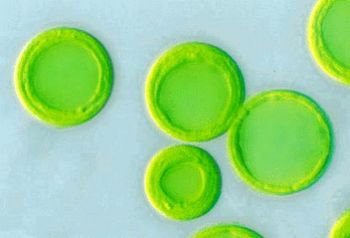Prochloron: Difference between revisions
No edit summary |
|||
| Line 30: | Line 30: | ||
==Ecology== | ==Ecology== | ||
[[Image:ascidian.jpg|thumb|250px|right|Ascidian, symbiont of ''Prochloron''. Image from [http://www.glenelgscuba.com.au/viewsite.php Glenelg Scuba Diving.]]] | |||
Prochlorons are distributed within the tissues of didemnid ascidians, mainly in the cloacal cavities under the upper tunic of the organism (see above image). Ascidians, or "sea squirts", are primarily known as a nusciance to humans. These sessile tunicates are found on most solid marine surfaces, including rocks, reefs, and algae. | Prochlorons are distributed within the tissues of didemnid ascidians, mainly in the cloacal cavities under the upper tunic of the organism (see above image). Ascidians, or "sea squirts", are primarily known as a nusciance to humans. These sessile tunicates are found on most solid marine surfaces, including rocks, reefs, and algae. | ||
==References== | ==References== | ||
Revision as of 14:55, 8 June 2006
|
NCBI: |

Classification
Higher order taxa:
Bacteria; Cyanobacteria; Prochlorales; Prochloraceae
Species:
Prochloron didemni, P. sp.
Description and Significance
Species of the Prochloron genus are oxyphotobacteria, or oxygenic photosynthetic prokaryotes. They are most prominent in tropical waters as symbionts with ascidians, commonly known as sea squirts. These organisms' unique photosynthetic morphology make them interesting to scientists who study the evolution of the features in photosynthesizers.
Genome Structure
Learning more about the genetics of Prochloron will help researchers to determine relationships between these bacteria and other photosynthesizers, especially because of their distinct functional and structural photosynthetic features.
Cell Structure and Metabolism
Currently there are studies being performed on Prochloron's photosynthetic machinery, as its morphology is unique among prokaryotes. Physically they are structurally similar to the photosynthetic apparatus of green plastids, with the thylakoids (the saclike membranes which house the chlorophyll within the cells) located in the peripheral cytoplasm of the bacteria's cells. This feature is one of the bases for the hypothesis that this bacteria is similar to the bacteria which evolved to become the first chloroplast within photosynthesizing eukaryotes. The photosynthetic pigment composition of Prochloron has similar characteristics of both cyanobacteria and chlorophytes.
Ecology

Prochlorons are distributed within the tissues of didemnid ascidians, mainly in the cloacal cavities under the upper tunic of the organism (see above image). Ascidians, or "sea squirts", are primarily known as a nusciance to humans. These sessile tunicates are found on most solid marine surfaces, including rocks, reefs, and algae.

